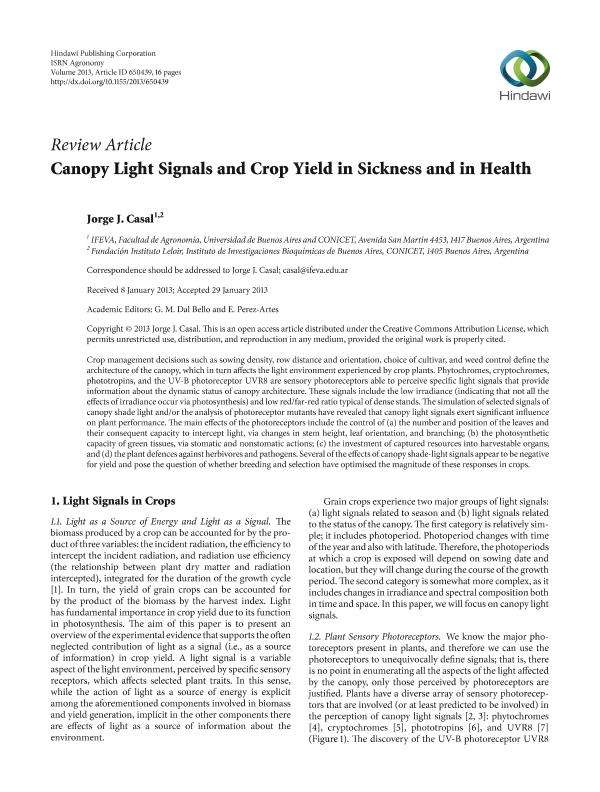Artículo
Canopy Light Signals and Crop Yield in Sickness and in Health
Fecha de publicación:
02/2013
Editorial:
Hindawi Publishing Corporation
Revista:
ISRN Agronomy
ISSN:
2090-7656
Idioma:
Inglés
Tipo de recurso:
Artículo publicado
Clasificación temática:
Resumen
Crop management decisions such as sowing density, row distance and orientation, choice of cultivar, and weed control define the architecture of the canopy, which in turn affects the light environment experienced by crop plants. Phytochromes, cryptochromes, phototropins, and the UV-B photoreceptor UVR8 are sensory photoreceptors able to perceive specific light signals that provide information about the dynamic status of canopy architecture. These signals include the low irradiance (indicating that not all the effects of irradiance occur via photosynthesis) and low red/far-red ratio typical of dense stands. The simulation of selected signals of canopy shade light and/or the analysis of photoreceptor mutants have revealed that canopy light signals exert significant influence on plant performance. The main effects of the photoreceptors include the control of (a) the number and position of the leaves and their consequent capacity to intercept light, via changes in stem height, leaf orientation, and branching; (b) the photosynthetic capacity of green tissues, via stomatic and nonstomatic actions; (c) the investment of captured resources into harvestable organs; and (d) the plant defences against herbivores and pathogens. Several of the effects of canopy shade-light signals appear to be negative for yield and pose the question of whether breeding and selection have optimised the magnitude of these responses in crops.
Palabras clave:
Shade
,
Crop Yield
,
Light
,
Photonorphogenesis
Archivos asociados
Licencia
Identificadores
Colecciones
Articulos(IFEVA)
Articulos de INST.D/INV.FISIOLOGICAS Y ECO.VINCULADAS A L/AGRIC
Articulos de INST.D/INV.FISIOLOGICAS Y ECO.VINCULADAS A L/AGRIC
Articulos(SEDE CENTRAL)
Articulos de SEDE CENTRAL
Articulos de SEDE CENTRAL
Citación
Casal, Jorge Jose; Canopy Light Signals and Crop Yield in Sickness and in Health; Hindawi Publishing Corporation; ISRN Agronomy; 2013; 2-2013; 650439-650439
Compartir




